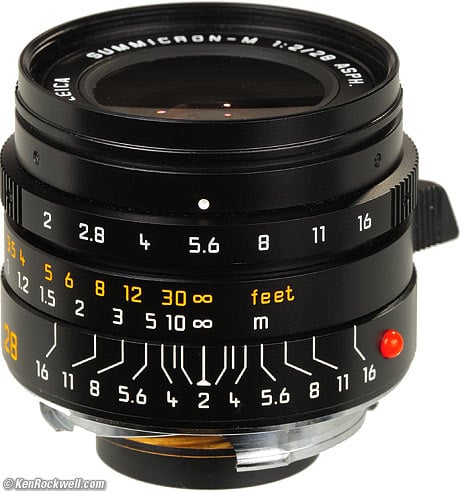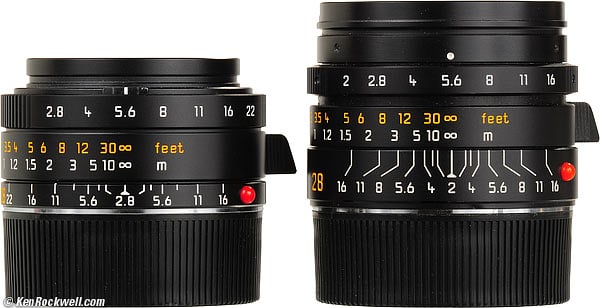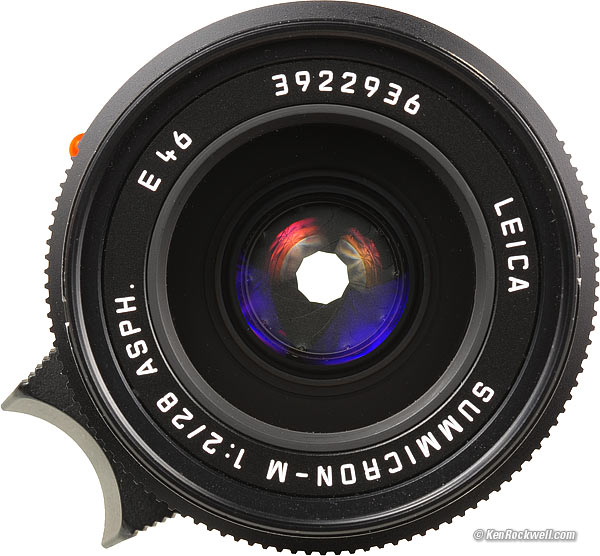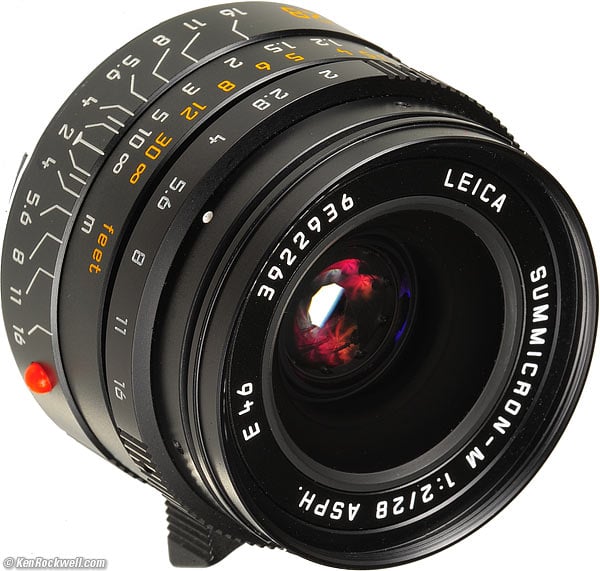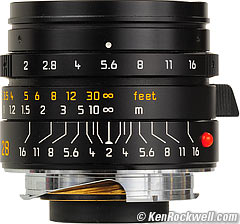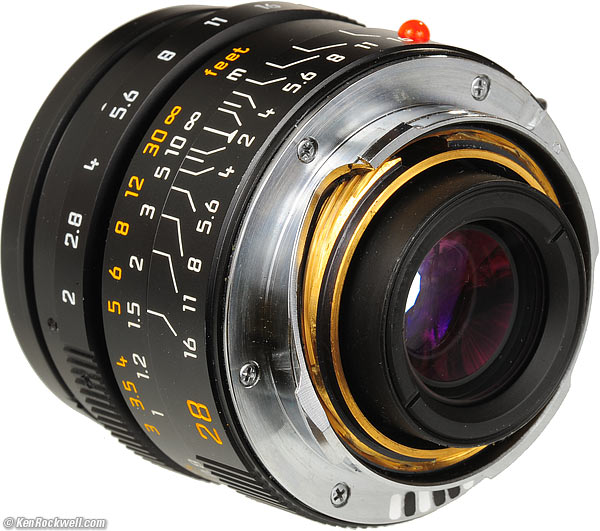Home Donate New Search Gallery How-To Books Links Workshops About Contact
LEICA 28mm f/2 ASPH
SUMMICRON-M (2000 - )
© 2010 KenRockwell.com. This page best with Corporate S regular and bold activated.
Intro Specs Performance Usage Compared Recommendations
Leica 28mm f/2 ASPH (46mm filters, 9.025 oz/255.9g), twice life-size. enlarge more. I'd get it at Adorama in black (11 604), Adorama in silver (11 661), Amazon in black, Amazon in silver, B&H in black, B&H in silver or Calumet. It helps me keep adding to this site when you get yours from these links, thanks!
May 2009
Leica Camera Reviews Leica Lens Reviews Recommended Leica Lenses
How to Use Wide Lenses How to Afford Anything Leica Lens Names
| Optics: | |
| Mechanics: | |
| Ergonomics: | |
| Usefulness: | |
| Availability: | |
| Overall: |
Ideal Uses
Journalism, and any place where you absolutely need f/2 instead of f/2.8.
Oddly, This 28mm f/2 works better on the Leitz Minolta CLE than on most Leica cameras. There is less finder blockage and the system weighs less!
Not for
This 28mm f/2 is big enough to block the camera's viewfinder. The Leica 28mm f/2.8 is a smaller, lighter lens that won't block your viewfinder, and has the same fantastic optical performance for a fraction of the price.
Introduction top
Intro Specs Performance Usage Compared Recommendations
This Leica 28mm f/2 Summicron-M is a wide-angle lens intended for journalists. Get this lens if you're willing to trade size, weight, price and a partially-blocked viewfinder in exchange for a one-stop gain in speed over the 28mm f/2.8 ASPH.
This 28mm f/2 will block the lower right corner of your viewfinder, unlike the smaller and less expensive 28mm f/2.8 ASPH.
If you're a journalist, you'll trade anything to get f/2, but for most people, including myself, the smaller, lighter 28mm f/2.8 lens does everything as well and doesn't block my viewfinder.
I'll refer both to the 28mm f/2.8 and 28mm f/2.8 ASPH and 28mm f/2 and 28mm f/2 ASPH; I mean the same lens in every case. I'm too lazy to type "ASPH" a million times; I'm not referring to older non-ASPH versions except in the history section.
Leica 28mm f/2.8 ASPH and Leica 28mm f/2 ASPH. enlarge.
Format
I'm shooting and testing these lenses on full-frame digital and film. I'm ignoring the half-frame M8, which should blow over as did Nikon's half-frame DX cameras.
Full frame digital? Easy! I have my lab scan everything as they run my film, so I already have every shot backed up at high-resolution (50MB) on DVD when I pick up my film. They do this cheaply enough that I have everything scanned as I have it processed. They're more than happy to do your film, too, by mail.
I load these DVDs into my system faster than fiddling with memory cards, and I'm done, at far higher resolution than if I wasted my time with an M8.
Actual Size
Presuming you have a standard 106 DPI monitor, this is its actual size, which is only two inches (5cm) long:
Leica 28/2, actual size. enlarge.
All of the illustrations in this review have been enlarged as not to look so silly.
|
I personally buy from Adorama, Amazon, Ritz, B&H, Calumet and J&R. I can't vouch for ads below.
|
This is Leica's first f/2 28mm lens.
Leica has made slower 28mm lenses since 1935.
28mm isn't that popular a focal length for fast lenses for Leica; this f/2 is as fast as it gets, while you can buy f/1.4 lenses in 21mm, 24mm, 35mm, 50mm and 75mm focal lengths.
If you want a faster 28mm lens, get the 35mm f/1.4 instead. The 24mm f/1.4 is too big, doesn't play well with filters and will demand the use of an external finder.
Specifications top
Usage Compared Recommendations
Name
Leica calls this the LEICA SUMMICRON-M 28mm f/2 ASPH.
"Summicron" means nothing except f/2, and "ASPH" is short for aspherical.
Focal Length top
Actual (design) Focal Length: 28.5mm.
35mm equivalent: 28mm. Duh, this is a full-frame 35mm lens.
Digital Equivalent: 28mm. Duh, I shoot full-frame have all my film scanned direct to digital.
Digital Resolution: 25MP when shot on film.
Equivalent on the Leica M8 (half-frame): 38mm.
Equivalent on the Epson R-D1x (half-frame): 43mm.
Angle of View (full-frame 35mm) top
75º Diagonal.
65º Horizontal.
46º Vertical.
(less on lesser formats.)
Optics top
9 elements in 6 groups.
One ground aspherical surface.
Multicoated.
Diaphragm top
10 blades.
Leica 28mm f/2 ASPH at f/5.6, 2.5x life-size. enlarge.
Blades are straight to f/4, inwardly curved from f/4.7 ~ f/9.5, and straight from f/11 ~ f/16.
Stops down to f/16.
Half-stop clicks.
Filter Thread top
46mm.
Germans call this E46 and 46E, but it's the same standard 46mm (0.75mm pitch) filter available everywhere.
46mm is larger than Leica's standard 39mm, but it is the same as the Contax G system, the Zeiss 21mm lenses and Leica's other larger lenses which include the 35mm f/1.4, 90mm f/2.8 Elmarit-M, 135mm f/4 Tele-Elmarit-M and others.
Close Focus top
Marked: 2.5 feet and 0.7 meters.
Actual measured: 26" or 66cm.
Maximum Reproduction Ratio top
1:22.
Caps top
Uses the standard Leica 14 269 rear cap.
Used without hood, use any 46mm snap-on cap or the real Leica 14 231 46mm front cap.
There is a flat 14013 cap (63 x 49mm) for use over the hood.
Hood top
Comes with a snap-on plastic hood, size A49, Leica part #12 451. It costs $150 to replace.
It is the same hood as supplied for the older 28mm f/2.8 non-ASPH.
There are two plastic release tabs which actuate four internal pins to lock the hood onto the lens. The base ring which houses the internal mechanics of this hood is metal.
The hood has a cut-out to obscure less of the finder, but the 28mm f/2 lens is so big that even the naked lens alone gets in the way of careful composition.
This hood cut-out lets you see if you have left your cap on as you sight thorugh the finder. Clever, those Germans.
Finder
If your camera lacks an integral 28mm finder, like the M3 or M7 0.85, Leica suggests either the discontinued 12 009 finder, the 21-24-28mm zoom finder (12 013) ($500) or Leica Universal Wide Finder (12 011) ($1,000).
Size top
Length: 40.7mm extension from flange, measured at infinity. (40.8mm specified.)
Diameter: 53.00mm, measured. The focus tab and red index dot protrude further.
Weights top
Naked lens, no caps: 9.025 oz. (255.9g), measured, black.
Lens with hood, no caps: 9.810 oz. (278.1g), measured, black.
Hood alone: 0.785 oz. (22.2g), measured.
Leica specifies "approximately 270 g," applying to the silver version as well.
Introduced top
2000.
Product Numbers top
Black Lens, complete: 11 604.
Silver Lens, complete: 11 661.
Each includes the boxed lens, paperwork and:
Hood: 12 451 ($150 if bought separately).
Hood Cap (63 x 49mm): 14 013 ($30 if bought separately).
Front Cap (used without hood, E46, 46mm snap-on ): 14 231 ($30 if bought separately).
Rear Cap: 14 269 ($27 if bought separately).
Fitted Leather Case.
Price, USA top
2010 November: $4,000 black, $4,200 silver.
2009, March: $4,000 black, $4,200 silver.
The silver model is made of all-brass and is heavier, while the black model is lighter anodized aluminum.
In the USA, there is an additional $300 Lens Rebate valid through 30 April, 2009.
Leica 28 2 ASPH. enlarge.
Performance top
Intro Specs Performance Usage Compared Recommendations
Overall
This Leica 28mm f/2 is the world's highest-performance 28mm lens.
It's fast, sharp and doesn't have any visible distortion.
The choices to consider when buying one is the fact that it's big enough to block some of the viewfinder, and that it takes 46mm as opposed to the Leica-standard 39mm filters.
Aperture Ring top
The aperture ring is perfect, like most current Leica lenses.
One fingertip is all you need to adjust it by feel alone.
Bokeh top
There is rarely anything out of focus, so bokeh has little meaning here.
If you shoot at f/2 at 0.9 meters, the background bokeh is neutral to a little weird.
Coma top
I can't see any coma (corner smearing of bright points of light).
I didn't push it, so maybe it will or won't have any on really bright points of light in the corners at f/2, but from my shooting, it wasn't there.
Depth-of-Field top
Depth-of-field is deep.
You can shoot at f/2 and have lots in focus, unlike with a 50mm lens, where nothing would be in focus.
This is normal for 28mm lenses.
Diaphragm Linearity top
My M7 agreed exactly as I tried every half-stop.
This shows a well-made lens.
It's not important when using TTL exposure meters, as with most modern cameras, but is important if you're using an external meter.
Distortion top
Surprise: Distortion is much less than expected. Yay!
I can't see any distortion, even when I look for it.
Lines running along a long edge stay straight, and there isn't any bulging of the center.
Even though the 28mm f/2.8 ASPH has a lower specified distortion, I can see any from either lens.
Ergonomics top
Leica 28/2, actual size. enlarge.
Ergonomics are perfect, except for being so big as to block the view finder.
Focus is as effortless and easy as all of Leica's other small lenses with a focus finger tab. All of these lenses focus the same way, and your finger goes to the same place at each distance regardless of lens, so an experienced pro can have his camera in focus purely by feel.
The aperture ring can be slightly hidden behind the hood mounting ring, but since the lock ring is smooth, it's trivial to locate each by feel.
Falloff (darkened corners)
Falloff is healthy at f/2, less at f/2.8, and gone for practical purposes by f/4.
Unlike SLR lenses, there is always a nice, artistic falloff towards the corners. It seems the same as the 28mm f/2.8. This helps keep the viewer's attention focused inside the photo, and keep his eyes from wandering off.
Filters, use with performance top
Any 46mm filter works great, but if you use the hood, you'll need to be careful and use filters of a small enough outside diameter over which the hood can slide.
Contax 46mm filters are too fat; you can't press the hood over them.
Hoya 46mm and B+W 46mm filters are fine. The outside diameters of each are 47.80mm (Hoya) and 48.00mm (B+W). The OD of the Contax filters are 49.00mm, too big for the hood to slip over.
Finder Blockage
On a Leica M7
Infinity |
Close-focus limit |
|
| No hood | minor-moderate |
moderate |
| With hood | moderate-severe |
severe |
On a Minolta CLE
Infinity |
Close-focus limit |
|
| No hood | minor |
minor-moderate |
| With hood | moderate |
strong |
On a Voigtländer Wide-Angle Camera (21mm finder)
Infinity |
Close-focus limit |
|
| No hood | minor-moderate |
moderate |
| With hood | strong |
severe |
A shortcoming of this lens for nature, landscape and any photography that demands careful composition is that this lens is so big that you see it in your image in the viewfinder. It gets in the way of seeing your subject.
Instead of seeing the lower right part of your subject, the finder sees some part of this lens instead!
The Leica 28mm f/2.8 ASPH is small enough that this doesn't happen. This is why this f/2 lens is for journalists, who work so fast that this doesn't bother them, and who use f/2 every evening.
With no hood and at infinity, about one-third of the lower right quadrant of the finder is blocked on an M7.
As you focus more closely, the lens extends and the finder moves to the lower right to correct parallax.
At the closest focus distance with no hood, one-half of the lower right quadrant of the finder is blocked.
Use the hood and you're asking for trouble.
With the hood, most of the lower right quadrant of your finder image is blocked by something, although you can see some out the hole which is cut in the hood.
This drives me crazy and, as a careful worker, why I didn't buy this lens instead of the f/2.8.
Journalists aren't bothered by this. The professional photographer who loaned me this lens shoots so fast, and always knows what's going on in his frame, so he doesn't even notice.
This is why I classify this lens as one for journalism: pro shooters don't care, but the careful landscape and fine art guys like me would go crazy not being able to see the lower right corner of our compositions.
Mechanics and Construction top
Rear, Leica 28/2 ASPH. enlarge.
The Leica 28mm f/2 ASPH is made exactly like every other Leica M lens, which is superbly. This is why Leica has the problem of some men buying these lenses as if they were jewelry, instead of tools.
In any case, this lens is made to last far beyond any of our life times. It will be taking pictures longer than I will.
I know: I've bought other lenses made like this that were bought 50 years ago by guys who never thought that the lenses they were buying to take photos of their kids would be inherited by those same kids and still used long after they were dead.
This of course brings us back to the jewelry problem: Leica lenses really are heirloom-grade.
Hood: Vented plastic, with plastic lock levers and metal base.
Front Cap: Snap-in plastic with plastic spring.
Barrel: Black anodized aluminum.
Focus Ring: Black anodized aluminum.
Focus Tab: Black plastic.
Aperture Ring: Black anodized aluminum.
Focus Helicoids: Brass.
Other Internals: Metal.
Mount: Dull chromed brass.
Mounting Index Dot: Red plastic ball.
Markings: Engraved and filled with paint.
Quality: Made in Germany.
Sharpness
The Leica 28mm f/2 ASPH is the worlds sharpest 28mm lens, but not by much.
It's always super sharp; center, corner, and everywhere in between, at every aperture.
The Leica 28mm f/2.8 ASPH and Contax G 28mm f/2.8 are as good for actual photography. Stop the lenses down to f/4 or smaller, and they are all indistinguishable from each other on split-screens, even at 36x enlargements (36 x 48" prints).
If you stand on a mountain and shoot down so everything is in perfect focus at infinity on a really clear day, and you shoot at f/2.8 in broad daylight (a dumb thing to do), the Leica 28mm f/2.8 ASPH is a very tiny bit less sharp at f/2.8 in the last couple of millimeters of the corners. Otherwise, it's the same throughout the image, even at f/2.8.
The only sharpness advantage of the 28mm f/2 is in the very last couple of millimeters in the far corners, and only at f/2.8, and of course the fact that the f/2 lens goes to f/2 and remains very sharp there, too.
Stopped down to f/4, these two Leica lenses are indistinguishable.
I'd rather have my finder clear all the time than get an ordinarily invisible sharpness improvement in the last 2mm of the corners at only f/2.8.
Usage top
Intro Specs Performance Usage Compared Recommendations
Hood
The hood blocks a lot of the finder, and makes it less easy to find the aperture ring.
If you want to use the hood:
Rotate the metal ring so the white dot is at the top.
Press the two release buttons and push it straight on.
Rotate it a little bit if you need to to get the hood to seat correctly; it's keyed to stay correctly oriented.
To remove, just press the release buttons and pull forward.
Use on the Minolta CLE
Focus, even at f/2, is accurate and consistent on my Minolta CLE.
This 28mm f/2 works even better on the Leitz Minolta CLE than other Leicas because there is less finder blockage, and because the CLE has a better 28mm finder than Leicas like the M7.
The finder of the CLE is farther away from the lens than on Leica-branded cameras. That's how it has less cut-off.
When this lens is mounted on the CLE, you'll see both the bold 28mm finder frame as well as the dimmer 90mm finder frame. Ignore the 90mm frame, which you have to do all the time on modern Leica cameras anyway.
On the CLE, there is only a small amount of blockage with no hood at infinity. At close focus distance with no hood, blockage is worse, but still not that bad.
Even with the hood, it's better than shooting this on an M7 or other similar Leica.
If I wanted to shoot this lens, I'd shoot it on a CLE without the hood and be happy. Metering, focus and everything works great.
A CLE with this lens weighs less than the 28mm f/2.8 on an M7: 655g total (28/2 and CLE) versus 805g (28/2.8 and M7)!
Compared to 28mm f/2.8 top
Intro Specs Performance Usage Compared Recommendations
Leica 28mm f/2.8 ASPH and Leica 28mm f/2 ASPH. enlarge.
28mm f/2 ASPH |
||
| Filter thread | 39mm |
46mm |
| Finder Blockage | None |
Moderate |
| Finder Blockage w/hood | Some |
Severe |
| Length | 30mm |
40.7mm |
| Weight (actual) | 6.107 oz. (173.18g) |
9.025 oz. (255.9g) |
| Diaphragm Blades | 10 |
10 |
| Minimum Aperture | f/22 |
f/16 |
| Distortion | ||
| Sharpness (MTF) | ||
| Price (3/09, USA) | $1,800 |
$4,000 ($4,200 silver) |
| Rebate (3/09, USA) | $300 |
$300 |
| Net Cost, New | $1,500 |
These lenses are equally sharp. I covered the only tiny difference in the Sharpness section above.
Distortion is the same in practice: invisible with either lens.
The real basis on which you should make a choice is size, weight, filter size, f/22 and whether you prefer an extra stop of speed in return for a partially blocked viewfinder.
Personally I prefer the smallest possible lens, 39mm filters and a clear finder, so I bought the 28mm f/2.8 ASPH. If I was a journalist, I'd get the f/2.
Recommendations top
Intro Specs Performance Usage Compared Recommendations
I bought the 28mm f/2.8 ASPH instead, because I'm a nature and landscape shooter who likes to travel light and compose carefully.
If I was a journalist, I'd opt for the f/2.
If speed is crucial, I'd consider the 35mm f/2 or 35mm f/1.4 instead, since 35mm isn't much less wide than 28mm, and those 35mm lenses are a stop faster than each of their 28mm counterparts.
The 35mm f/2 shares the same size, weight and lack of finder blockage as the 28 f/2.8, and the 35mm f/1.4 is the analog to this 28mm f/2.
Deployment
The hood blocks the finder.
I'd use a 46mm 81A B+W brand filter for slide film.
I'd use any 46mm B+W brand yellow filter for B&W film outdoors or a 46mm Leica brand UV filter indoors.
I'd use a 46mm Leica brand UV filter 13 004 for color print film, but why would anyone shoot color print film in a Leica?
I wouldn't bother with a digital Leica until they come out with a full-frame body, and even then film is more fun, but that's just me. I'm told digital shooters today need to use a Leica brand 46mm UV/IR filter 13 411 (or a B+W brand 46mm UV/IR filter) to correct for a design flaw in the M8.2's sensor system design.
Acknowledgment: Many thanks to Ralph Starkweather for his help getting me this lens to review.
More Information:
PLUG
I support my growing family through this website.
If you find this as helpful as a book you might have had to buy or a workshop you may have had to take, feel free to help me continue helping everyone.
If you've gotten your gear through one of my links or helped otherwise, you're family. It's great people like you who allow me to keep adding to this site full-time. Thanks!
If you haven't helped yet, please do, and consider helping me with a gift of $5.00.
The biggest help is when you use any of these links when you get anything. It costs you nothing, and is this site's, and thus my family's, biggest source of support. These places always have the best prices and service, which is why I've used them since before this website existed. I recommend them all personally.
Thanks for reading!
Ken
Home Donate New Search Gallery How-To Books Links Workshops About Contact

